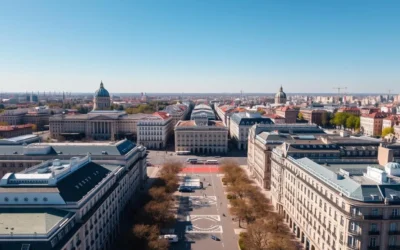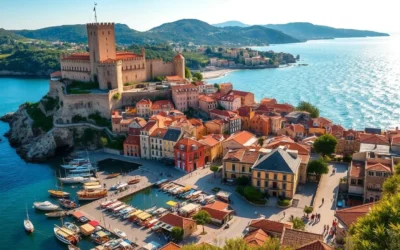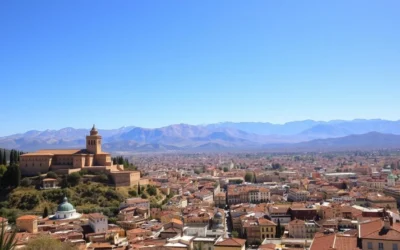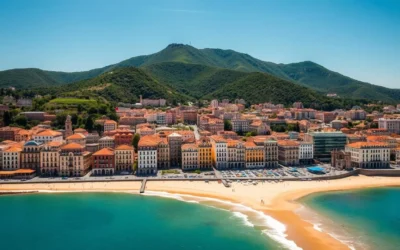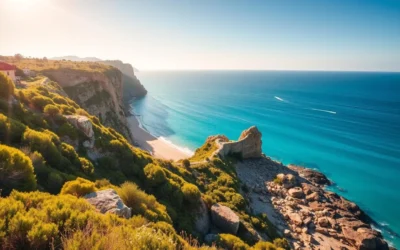✓ Accommodations✓ Flights✓ Rental Cars✓ Tours & Activities
Nestled in the heart of southern Spain’s Andalusia region, Córdoba is a city that will transport you back in time. With its rich multicultural heritage, this captivating city offers a unique blend of Roman, Moorish, and Christian influences that will leave you in awe.
As you wander through the historic streets, you’ll discover the city’s top attractions, from the breathtaking Mezquita-Cathedral to the charming flower-filled patios. Your visit to this enchanting city will be a memorable experience, with its vibrant culture and historical landmarks.
With four UNESCO World Heritage designations, Córdoba is a city that rewards visitors who stay beyond just a day trip. Whether you’re interested in history, architecture, or simply soaking up the atmosphere, you’ll find that there’s always something new to explore in this captivating city.
Discovering the Magic of Córdoba
As you step into Córdoba, you’re immediately enveloped in a rich tapestry of history, architecture, and vibrant culture. The city’s unique charm comes from being a place where three major cultures—Christian, Muslim, and Jewish—have left their indelible mark on the architecture, cuisine, and traditions.
A City of Three Cultures
Córdoba’s history is a fascinating story of cultural convergence. For five centuries, the city was under Muslim rule and became one of Europe’s largest and most cosmopolitan capitals, a center of learning and culture that rivaled Baghdad and Constantinople. This blend of influences is still visible in the city’s architecture, from Roman ruins to Moorish palaces and Christian churches. You can experience this rich heritage by exploring the city’s many monuments, including the Mezquita-Catedral, a UNESCO World Heritage Site.
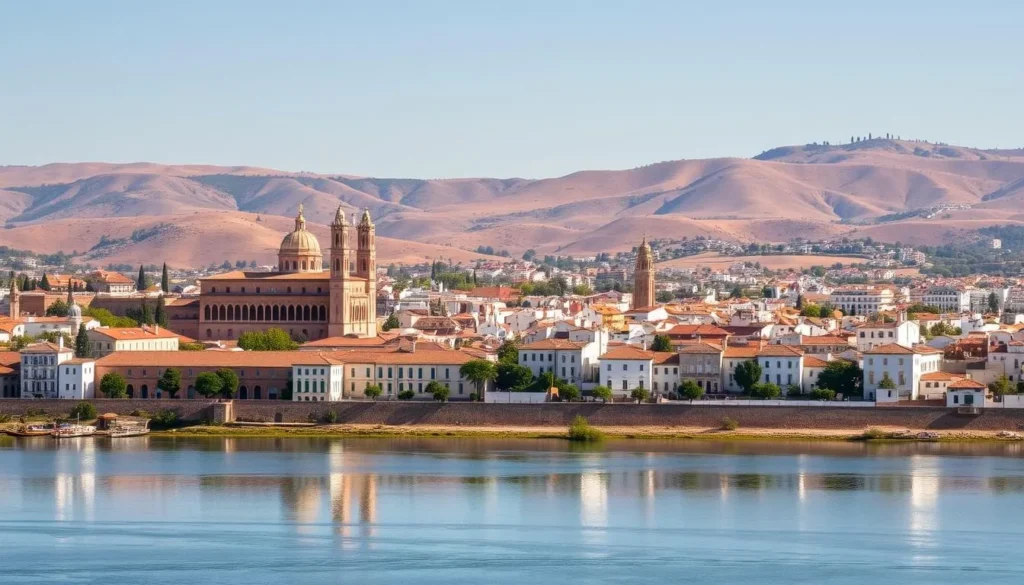
Best Time to Visit Córdoba
Planning your time visit to Córdoba is crucial to enjoying the city’s delights. The best times to visit are during spring (April-May) when the famous Patio Festival takes place, or in fall (September-October) when temperatures are pleasant and tourist crowds have thinned. Summer months can be extremely hot, while winters offer a unique experience with fewer tourists and mild temperatures. You can enjoy the city’s historic center, decorated with special holiday lights and decorations, making it a lovely city to explore.
Whether you’re strolling through the narrow streets of the Jewish Quarter, visiting the Roman Bridge, or simply soaking up the atmosphere in one of Córdoba’s many plazas, you’re sure to have a memorable experience in this captivating city.
La Mezquita-Catedral: Córdoba’s Crown Jewel
La Mezquita-Catedral de Córdoba, a UNESCO World Heritage site, is an architectural masterpiece. This 8th-century mosque turned cathedral is one of the world’s grandest examples of Moorish architecture, representing an extraordinary fusion of Islamic and Christian styles.
![]()
The History Behind the Mosque-Cathedral
The original Mosque was built in the 8th century during the rule of Emir Abd al-Rahman I of the Islamic Umayyad dynasty. The mosque was constructed to rival the grandeur of great mosques in northern Africa and the Middle East. After Córdoba was captured by Christian forces in the 13th century, the mosque was converted into a cathedral. Significant renovations took place in the 16th century, including the addition of a Renaissance-style cathedral nave and bell tower, blending Islamic and Christian architectural elements.
The Mezquita-Catedral stands as Córdoba’s most iconic monument, showcasing a unique religious space unlike any other in the world. Its history reflects the cultural and religious shifts in Córdoba over the centuries.
What to See Inside the Mezquita
As you enter the Mezquita-Catedral, you’ll be struck by the forest of 856 columns topped with red and white striped arches, creating a mesmerizing visual effect. Inside, you’ll find the mihrab (prayer niche) adorned with intricate Byzantine mosaics, the Renaissance cathedral nave, and numerous chapels filled with religious artwork.
The Mezquita’s architecture is a testament to the skill and craftsmanship of the people who built it over the centuries. Each element, from the arches to the mosaics, tells a story of cultural exchange and architectural innovation.
Practical Tips for Visiting
For the best experience, visit the Mezquita-Catedral early in the morning (before 10 AM) or during lunchtime when crowds are thinner. Consider booking a guided tour to fully understand the complex history and architectural significance of this remarkable site.
By planning your visit strategically, you can enjoy a more peaceful and enriching experience at this incredible heritage site.
Alcázar de los Reyes Cristianos: Royal Fortress
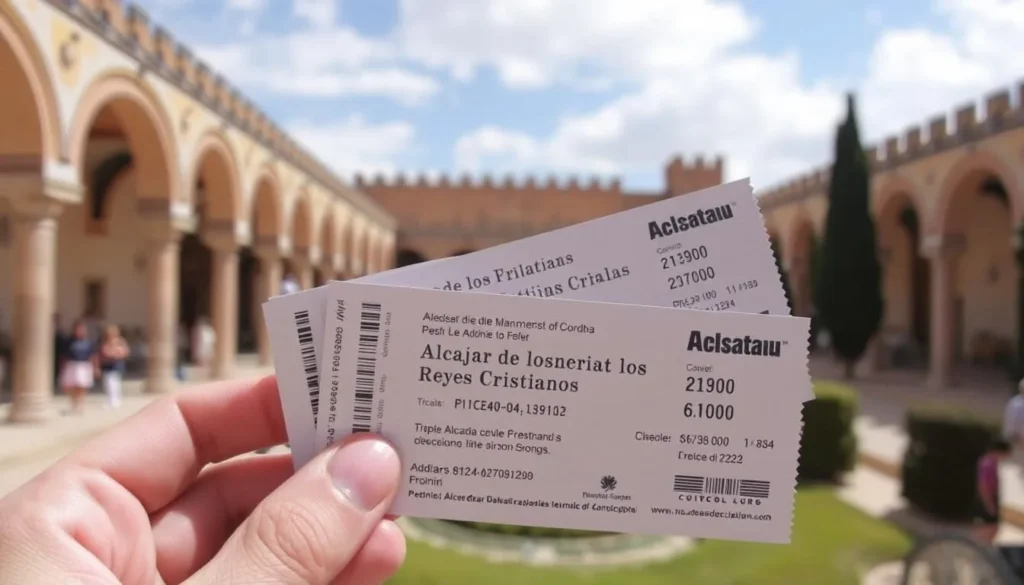
As you wander through Córdoba, the Alcázar de los Reyes Cristianos emerges as a significant historical gem, reflecting the city’s layered past. This fortified palace and garden complex, situated along the northern bank of the Guadalquivir River, is a must-visit destination for anyone interested in history, architecture, or simply exploring the beauty of Spain.
The Palace and Its History
The Alcázar de los Reyes Cristianos, or the Castle of the Christian Monarchs, is a stunning medieval fortress-palace that served as a royal residence for Ferdinand and Isabella, the Catholic monarchs who financed Columbus’s voyages. Built in the 14th century on the site of a former Moorish fortress, the Alcázar showcases the Mudéjar architectural style, which blends Islamic and Christian design elements. This unique style is a testament to the cultural exchange and influence that occurred in the region after the reconquest.
The palace played a significant role in Spanish history, serving as a meeting place where Christopher Columbus discussed his plans to reach Asia by sailing west with the Catholic monarchs. Throughout its history, the palace has had many roles, including a royal residence, a prison, and even the official headquarters of the Spanish Inquisition.
The Magnificent Gardens
The magnificent gardens of the Alcázar de los Reyes Cristianos are a highlight for many visitors. Featuring meticulously manicured hedges, elegant fountains, reflecting pools, and a variety of trees including cypresses, palms, oranges, and lemons arranged in geometric patterns, the gardens are a serene oasis in the heart of the city. As you stroll through the gardens, you can appreciate the tranquility and beauty that has been carefully preserved.
Visitor Information and Tips
When visiting the Alcázar de los Reyes Cristianos, allocate at least 2 hours to fully explore both the palace interiors and the extensive gardens. Consider arriving early in the morning to avoid crowds and capture the best photos of the gardens. The site is open to visitors throughout the year, although it’s advisable to check the official website for any updates on opening hours and ticket prices.
To make the most of your visit, take your time to explore the intricate details of the palace and gardens. The combination of history, architecture, and natural beauty makes the Alcázar de los Reyes Cristianos a truly unforgettable experience.
Exploring the Jewish Quarter (La Judería)
The Jewish Quarter, or La Judería, is a labyrinthine neighborhood that offers a glimpse into Córdoba’s rich cultural heritage. As you wander through its narrow, winding streets, you’ll be surrounded by whitewashed buildings and charming interior courtyards that create a magical atmosphere in this historic city.
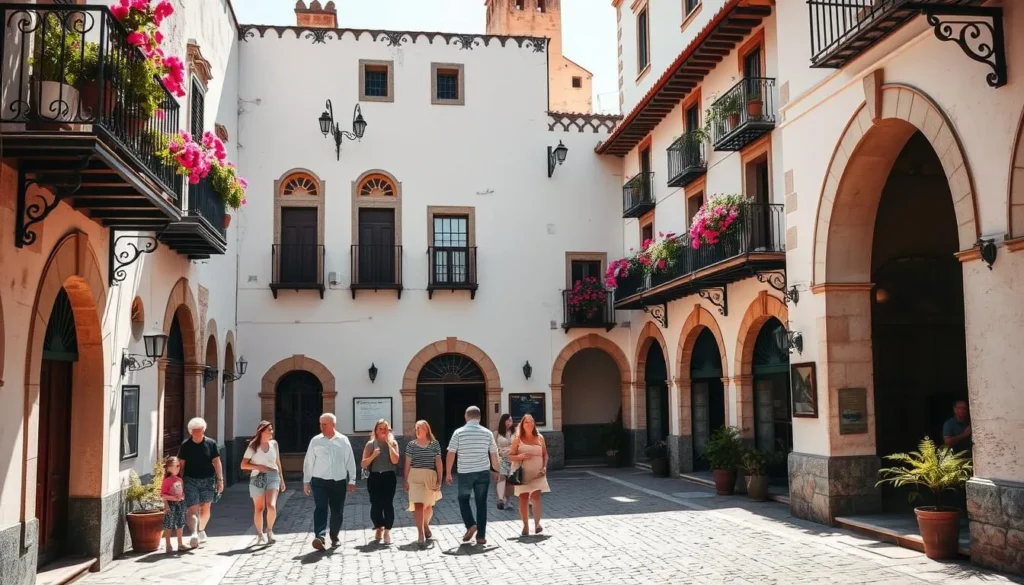
Córdoba Synagogue
One of the highlights of La Judería is the Córdoba Synagogue, built in 1315. This Mudéjar-style synagogue is one of only three original synagogues remaining in Spain and features intricate floral and geometric patterns. Visiting the synagogue provides a unique experience, allowing you to step back in time and appreciate the rich history of the Jewish community in Córdoba.
Calleja de las Flores
No visit to La Judería is complete without a visit to Calleja de las Flores, one of the most photographed streets in Córdoba. This picturesque alley is adorned with colorful potted flowers against white-washed walls, creating a breathtaking scene. At the end of the alley, the Mezquita’s tower adds a touch of grandeur to this charming cityscape.
Shopping for Local Crafts
La Judería is renowned for its traditional craftsmanship, particularly in silverwork and leather goods. As you explore the quarter, you’ll come across numerous artisan workshops where you can watch craftspeople at work. These places offer the perfect opportunity to purchase authentic souvenirs, making your visit to La Judería a memorable experience.
| Attraction | Description | Must-See Features |
|---|---|---|
| Córdoba Synagogue | Mudéjar-style synagogue built in 1315 | Intricate floral and geometric patterns |
| Calleja de las Flores | Picturesque alley with colorful flowers | White-washed walls, Mezquita’s tower in the background |
| Local Crafts | Traditional silverwork and leather goods | Authentic souvenirs, artisan workshops |
Roman Bridge and Torre de la Calahorra
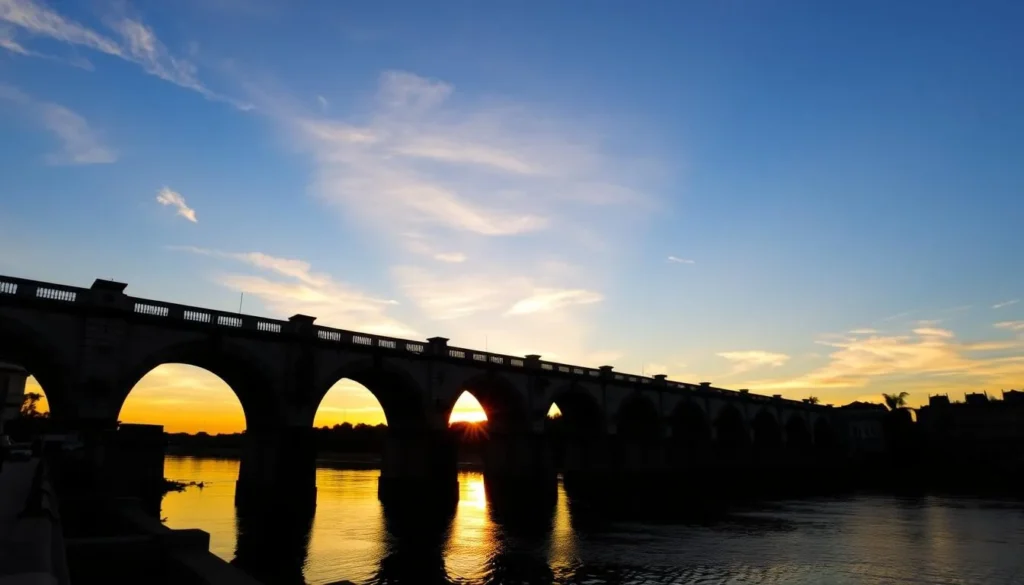
Córdoba’s Roman Bridge is more than just a crossing over the Guadalquivir River; it’s a journey through time. Dating back to the 1st century AD, this ancient bridge has been a silent witness to the city’s history, undergoing several renovations over the centuries.
Walking the Ancient Bridge
As you walk across the Roman Bridge, you’re treated to spectacular views of the city skyline. The Mezquita and Alcázar create a stunning backdrop, especially at sunset. This pedestrian-only bridge is not just a means to cross the river; it’s an experience, offering a glimpse into Córdoba’s rich past.
The bridge’s 17 stone arches stand as a testament to Roman engineering, and its honey-colored stones glow warmly in the sunlight. As a fan of Game of Thrones, you might recognize the bridge as the Long Bridge of Volantis, adding another layer of interest to your visit.
Climbing the Tower for Panoramic Views
At the southern end of the bridge stands the Calahorra Tower, a fortified gate tower built by the Moors in the 12th century. Climbing to the top rewards you with panoramic views of the historic center, the Roman Bridge, and the surrounding countryside.
The tower also houses a small museum that tells the story of the peaceful coexistence of Christians, Muslims, and Jews during medieval Córdoba. As you enjoy the views, you can reflect on the rich cultural heritage that makes Córdoba such a unique city.
The Famous Patios of Córdoba
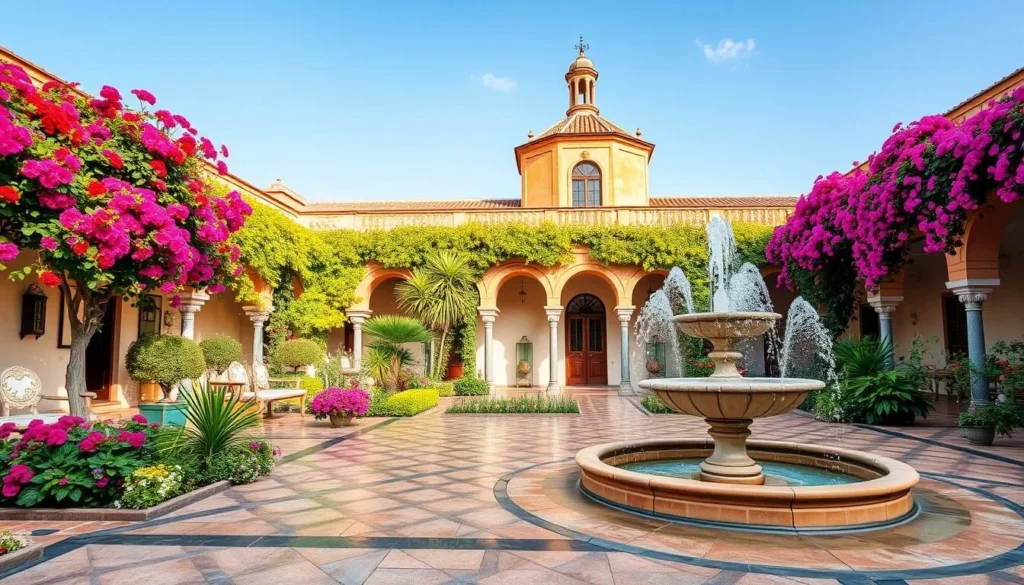
As you wander through Córdoba, you’ll discover the famous patios that have become a hallmark of this charming Spanish city. The patios of Córdoba are a true marvel, showcasing vibrant flowers, rushing fountains, and intricate tilework that reflect the city’s rich cultural heritage.
The Festival of Patios
The Festival of Patios (Fiesta de los Patios) is a significant event held in May, where residents open their private courtyards to the public, competing for the title of the most beautiful patio in Córdoba. This festival is a celebration of the city’s architectural heritage and its people’s love for garden art. During this time, you can experience the patios in all their glory, with vibrant flowers and lush greenery on full display.
Best Patios to Visit Year-Round
While the Patio Festival is a highlight, many of Córdoba’s patios are open to the public throughout the year. Notable mentions include the patios in Palacio de Viana and Patios de San Basilio, where you’ll find cascading geraniums, jasmine, orange trees, and fountains creating tranquil oases. These patios are a testament to the city’s historical adaptation to its climate and the social importance of these shared spaces.
Photography Tips for Patio Visits
To capture the beauty of Córdoba’s patios, visit in the morning when the light is softer. Bring a wide-angle lens to capture the entire courtyard, and focus on details like the contrast between colorful flowers against whitewashed walls. This will help you create stunning photographs that reflect the essence of these beautiful patios.
The patios of Córdoba represent a living tradition that has been recognized by UNESCO as Intangible Cultural Heritage. Whether you’re visiting during the festival or at any other time of the year, these patios are an experience not to be missed. So, take your time to visit and appreciate the beauty and history that these patios have to offer.
Palacio de Viana: A Palace of Patios
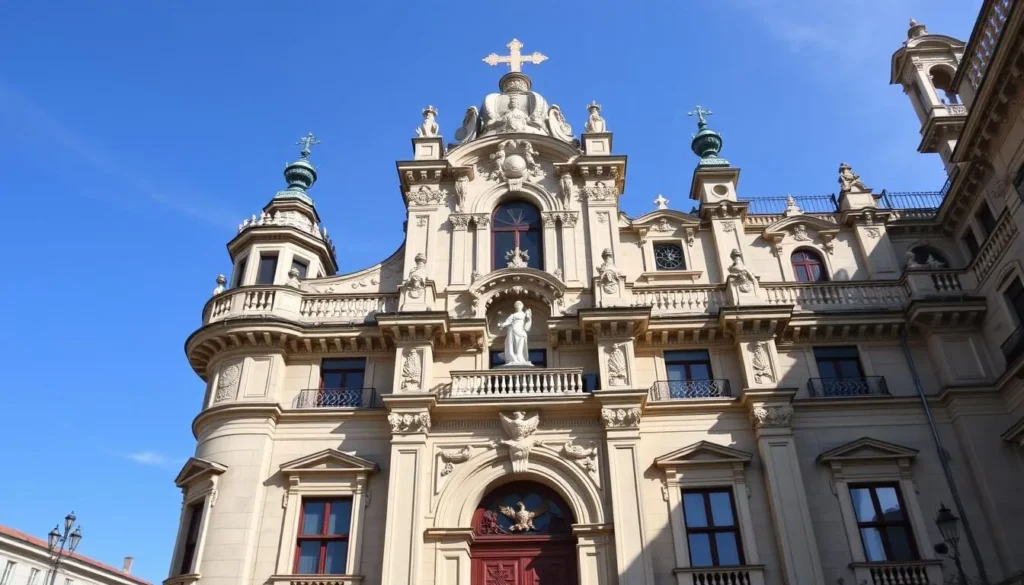
Palacio de Viana, a majestic 15th-century palace, stands as a testament to the rich history and architectural splendor of Córdoba. This grand stately home is renowned for its 12 beautifully designed traditional patio gardens that function almost as outdoor rooms, creating a serene and enchanting atmosphere.
The History of the Palace
Palacio de Viana, known as the “Museum of Patios,” is a 15th-century aristocratic mansion that showcases the evolution of Córdoban patio design across five centuries of continuous habitation and renovation. The palace belonged to the Marquises of Viana until 1980 when it was acquired by a bank foundation and transformed into a museum that preserves both the building’s architectural heritage and its extensive collection of art, tapestries, ceramics, and antique furniture.
Exploring the 12 Unique Patios
What makes Palacio Viana truly special is its collection of 12 distinct patios, each with its own theme, design, and plant selection, ranging from the formal Reception Patio to the romantic Garden Patio and the functional Well Patio. As you move through the palace, you’ll experience how these patios served different purposes throughout history, from practical spaces for washing and cooking to elegant areas for social gatherings and quiet contemplation.
The palace offers two ticket options: a complete tour including both the patios and the interior rooms with their collections, or a patios-only ticket for those primarily interested in the garden architecture. Visitors can immerse themselves in the beauty and history of Palacio de Viana by choosing the ticket that best suits their interests.
Medina Azahara: The Shining City
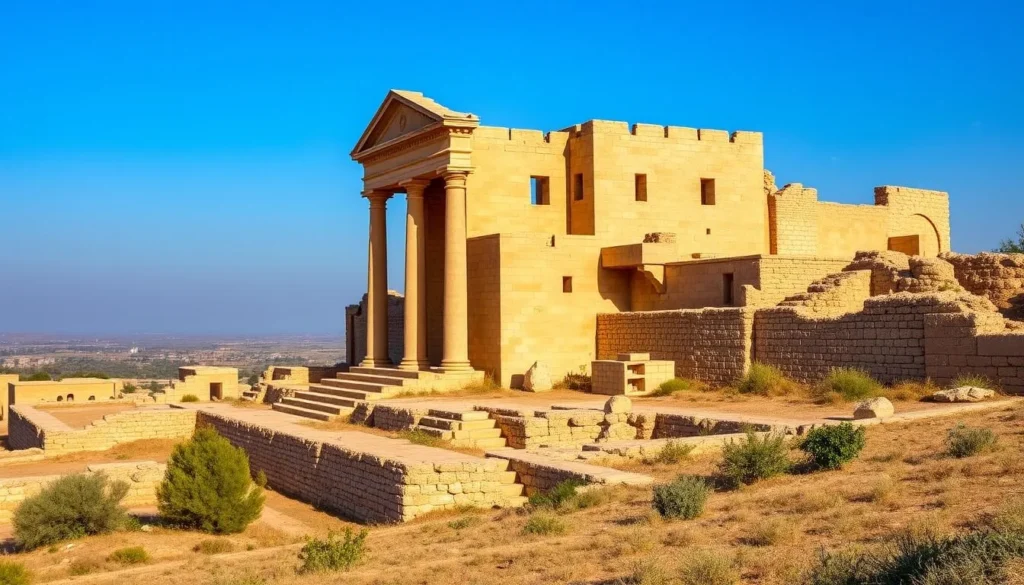
As you step into the ruins of Medina Azahara, you’re transported to a time when Córdoba was the epicenter of power and culture in al-Andalus. This magnificent palace-city, built in the 10th century by Caliph Abd al-Rahman III, was a symbol of his power and a rival to other great Islamic capitals of the time.
The History of the Palace Complex
Medina Azahara, or Madinat al-Zahra, was constructed as the administrative capital of al-Andalus, housing up to 30,000 people. Despite its grandeur, the city was destroyed during civil wars just 70 years after its construction. The site remained lost until its rediscovery in the early 20th century, and it is now a UNESCO World Heritage Site.
The history of Medina Azahara is a story of ambition, power, and eventual decline. Built to showcase the Caliph’s wealth and influence, the city’s destruction marked the beginning of the end of the Caliphate of Córdoba.
What to See at the Archaeological Site
Today, visitors to Medina Azahara can explore the remains of this once-great city. Highlights include the Rich Hall (Salón Rico) with its intricate marble decorations, the House of Ja’far, the Caliph’s residence, and remnants of gardens and water features that demonstrate the advanced engineering of the period.
As you wander through the site, you can almost imagine the grandeur of Medina Azahara during its heyday, with its gleaming marble facades visible from miles away.
How to Get There from Córdoba
Medina Azahara is located about 8 km west of Córdoba, making it an easy day trip. You can take the official shuttle bus from the city center, join an organized tour, or drive yourself. Be sure to start at the modern visitor center, which houses an excellent museum explaining the site’s historical context.
Visiting Medina Azahara is a journey through time, offering insights into the history and culture of the Caliphate era. With its rich history, stunning architecture, and picturesque surroundings, it’s a must-visit destination for anyone interested in exploring beyond Córdoba.
Córdoba, Spain: Best Things to Do for Food Lovers
As you wander through the historic streets of Córdoba, you’ll discover that the city’s culinary delights are just as captivating as its architectural treasures. The city’s cuisine is a vibrant reflection of its multicultural heritage, blending Roman, Arabic, Jewish, and Christian influences to create a unique gastronomic experience.
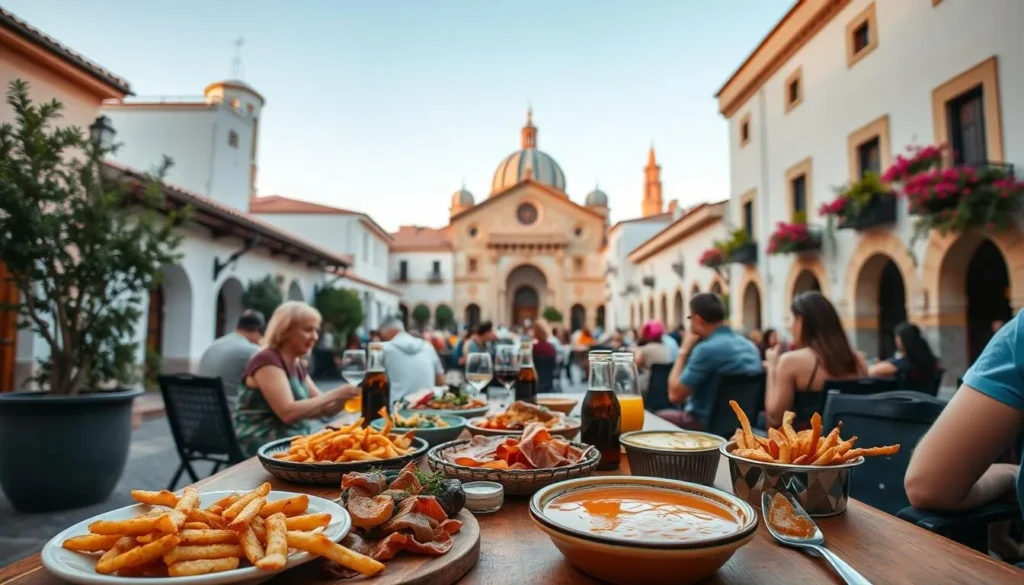
Must-Try Local Dishes
Córdoba’s signature dish is salmorejo, a creamy cold tomato soup that’s a staple on most traditional Cordoban menus. Made with ripe tomatoes, garlic, olive oil, and bread, it’s sometimes topped with boiled eggs and crispy gammon pieces. You should also try flamenquín (rolled and fried pork loin with ham), rabo de toro (oxtail stew), and berenjenas con miel (fried eggplant drizzled with honey), which showcase the region’s love for bold flavors.
These dishes are not only delicious but also reflect the city’s rich cultural diversity. For instance, salmorejo is a testament to the Arabic influence on Cordoban cuisine, while flamenquín highlights the region’s meat-based dishes.
Top Restaurants and Tapas Bars
For an authentic dining experience, head to traditional tabernas like Bodegas Campos, Casa Pepe de la Judería, or Taberna Salinas. These establishments offer local dishes in historic settings, providing a culinary experience that’s deeply rooted in the city’s traditions.
When dining in Córdoba, be sure to explore the city’s tapas culture. Many tabernas and tapas bars are dotted around the city, showcasing their delicious offerings at the storefront. It’s a great way to experience the local cuisine and socialize with the friendly locals.
Wine Tasting in Córdoba
No visit to Córdoba is complete without tasting the local wines, particularly Montilla-Moriles, a fortified wine similar to sherry. With varieties ranging from dry fino to sweet Pedro Ximénez, there’s a wine to pair perfectly with local desserts. Take the opportunity to visit a local winery or wine bar to sample some of these exceptional wines.
Enjoying tapas and a glass of wine is a quintessential Cordoban experience. As you savor the local flavors, you’ll understand why Córdoba is a paradise for food lovers.
Cultural Experiences in Córdoba
Immerse yourself in Córdoba’s culture by experiencing the city’s most iconic performances and traditions. Córdoba is a city that offers a rich cultural experience, blending history and entertainment. You can enjoy various cultural activities during your visit to this beautiful city.
Flamenco Shows
Flamenco is a spirited, rhythmical dance that moves to the beat of a guitar, and Córdoba is well known for its Flamenco culture. Tablao El Cardenal is one of Córdoba’s most iconic flamenco venues, offering authentic performances that showcase the emotional intensity and technical skill of this UNESCO-recognized cultural expression.
Equestrian Shows at the Royal Stables
The Royal Stables of Córdoba, founded in 1570, are not only a historic marvel but also host some incredible equestrian shows. Each performance celebrates the skills of elegant horses, who wear elaborate costumes and follow synchronized routines to traditional music, demonstrating their legendary grace and power.
Hammam Al Ándalus: Arab Baths Experience
For a truly immersive cultural experience, visit Hammam Al Ándalus, a modern recreation of traditional Arab baths. This luxurious Arabian-style bathhouse allows you to relax in thermal pools while surrounded by marble, intricate tilework, and star-shaped skylights reminiscent of Córdoba’s Moorish past.
These cultural experiences connect you directly to Córdoba’s multicultural heritage, offering not just entertainment but a deeper understanding of the traditions that have shaped the city’s identity over centuries. To make the most of these popular attractions, be sure to book tickets in advance, especially during high season.
Museums Worth Visiting in Córdoba
When visiting Córdoba, you can explore several museums that highlight the city’s diverse past and artistic achievements. These cultural institutions offer a welcome respite from the heat and crowds, providing a deeper understanding of Córdoba’s rich history.
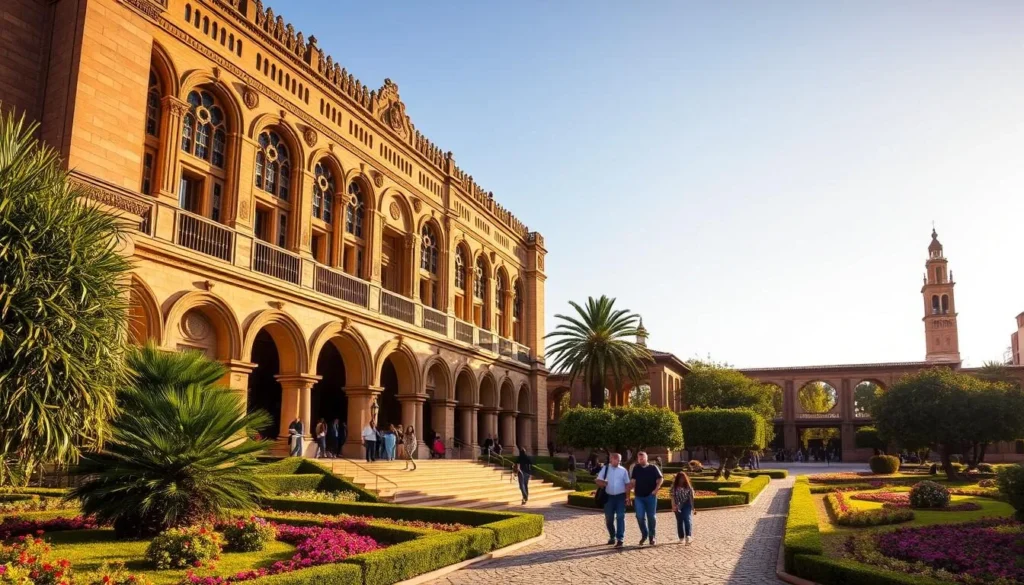
Archaeological Museum of Córdoba
The Archaeological Museum of Córdoba is a must-visit to understand the city’s full history, from prehistoric times to the present day. Housed in a Renaissance palace, the museum takes visitors on a chronological journey through the city’s past, featuring artifacts from Roman, Visigothic, Islamic, and Christian periods. A highlight of the museum is the basement level, where you can walk through the remains of a Roman theater discovered during renovations, offering a unique glimpse into the city’s archaeological layers.
Museo Julio Romero de Torres
The Museo Julio Romero de Torres celebrates Córdoba’s most famous painter, Julio Romero de Torres, known for his powerful portraits of women that capture the essence of Andalusian culture. The museum is located in a beautiful plaza surrounded by orange trees and jasmine, adding to its charm. Romero de Torres’ works, created in the early 20th century, blend realism with symbolism and local folklore, making this museum a significant cultural stop in Córdoba.
Fine Arts Museum
The Fine Arts Museum, or Museo de Bellas Artes, showcases an impressive collection of Spanish paintings and sculptures from the 14th to 20th centuries. Housed in a former hospital building with beautiful courtyards, the museum offers a serene atmosphere to appreciate the art. The collection highlights mostly Spanish artists from the Renaissance to the present, providing insight into the country’s artistic evolution over the centuries.
These museums are not only repositories of art and history but also serve as tranquil oases in the heart of the city. Most entrance fees are under €5, making them an affordable way to spend your time exploring Córdoba’s cultural heritage.
Day Trips from Córdoba
Córdoba is a great base for day trips to discover the best of Andalusia. You can experience the region’s diverse landscapes, rich history, and vibrant culture by taking a day trip to nearby attractions.
Sierras Subbeticas National Park
Just an hour’s drive from Córdoba, the Sierras Subbeticas National Park offers a perfect day trip for nature lovers. The park is known for its dramatic limestone mountains, olive groves, and diverse wildlife, providing a quintessential Andalusian landscape experience.
- The park’s Via Verde, a converted railway line, provides an easy hiking or cycling route through stunning landscapes.
- Rental bikes are available in nearby towns for those who want to explore on two wheels.
Taking a way through the park’s scenic trails, you can enjoy the beautiful mountainside villages and viewpoints. It’s a great place to spend the day, enjoying the natural beauty of Andalusia.

Nearby Andalusian Towns
In addition to the Sierras Subbeticas National Park, there are several charming Andalusian towns worth visiting on a day trip from Córdoba. You can reach these towns by car or by joining an organized tour that departs from Córdoba’s city center.
- Zuheros, perched dramatically on limestone cliffs, is a charming white-washed town.
- Priego de Córdoba, known as the “Baroque jewel of Andalusia,” is another excellent destination.
- Montilla is famous for its wineries producing the distinctive fortified wines of the region.
- Almodóvar del Río boasts an impressive medieval castle featured in Game of Thrones.
When planning your day trip, consider renting a car for maximum flexibility, or join an organized tour if you prefer to leave the logistics to someone else. This way, you can make the most of your time and enjoy the region’s hidden gems.
Exploring Córdoba on a Budget
Córdoba is a surprisingly affordable destination in Spain. You can experience the city’s rich cultural heritage and beauty without spending a fortune. The key is to know where to look and how to plan your visit.
Free Attractions and Activities
Córdoba offers a variety of free attractions and activities that allow you to enjoy the city on a budget. Take advantage of free entry times at major attractions like the Mezquita-Catedral, which is free on Monday-Saturday from 8:30-9:30 AM. You can also visit the Alcázar gardens for free on Wednesdays after 2 PM. Wandering through the historic neighborhoods, such as the Jewish Quarter, and walking across the Roman Bridge are other great ways to experience the city’s charm without spending money.
- Explore the atmospheric streets of the Jewish Quarter.
- Walk across the Roman Bridge.
- Visit the Mezquita-Catedral during free entry times.
- Enjoy the Alcázar gardens on Wednesdays after 2 PM.
Money-Saving Tips
Saving money in Córdoba is easy with a few simple tips. Enjoy a “menú del día” (fixed price lunch menu) at local restaurants, which typically includes three courses and a drink for €10-15. You can also create your own picnic with fresh produce from Mercado Victoria. If you plan to visit multiple paid attractions, consider purchasing the Córdoba Card, which includes entry to main monuments plus public transportation at a discounted rate.
| Attraction | Free Entry Time | Regular Price |
|---|---|---|
| Mezquita-Catedral | Monday-Saturday, 8:30-9:30 AM | €10 |
| Alcázar Gardens | Wednesdays after 2 PM | €7 |
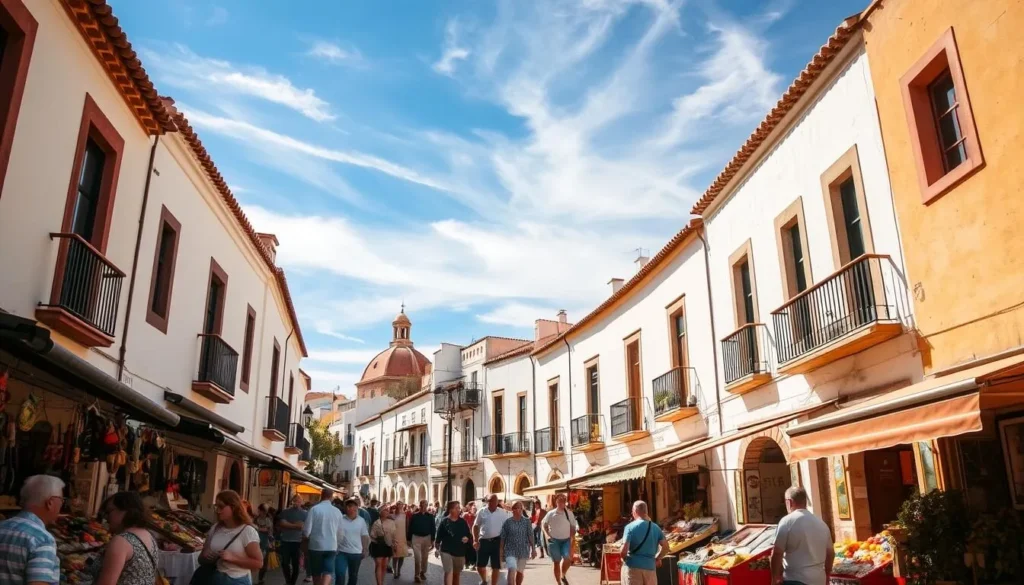
By taking advantage of these free attractions and money-saving tips, you can enjoy all that Córdoba has to offer without breaking the bank. Whether you’re strolling through the historic neighborhoods or visiting the city’s famous landmarks, there’s a way to experience Córdoba on your budget.
Where to Stay in Córdoba
From luxury hotels to budget-friendly hostels, Córdoba has a wide range of options for visitors to stay and enjoy the city. The key to a great stay is choosing a location that suits your travel plans and budget.
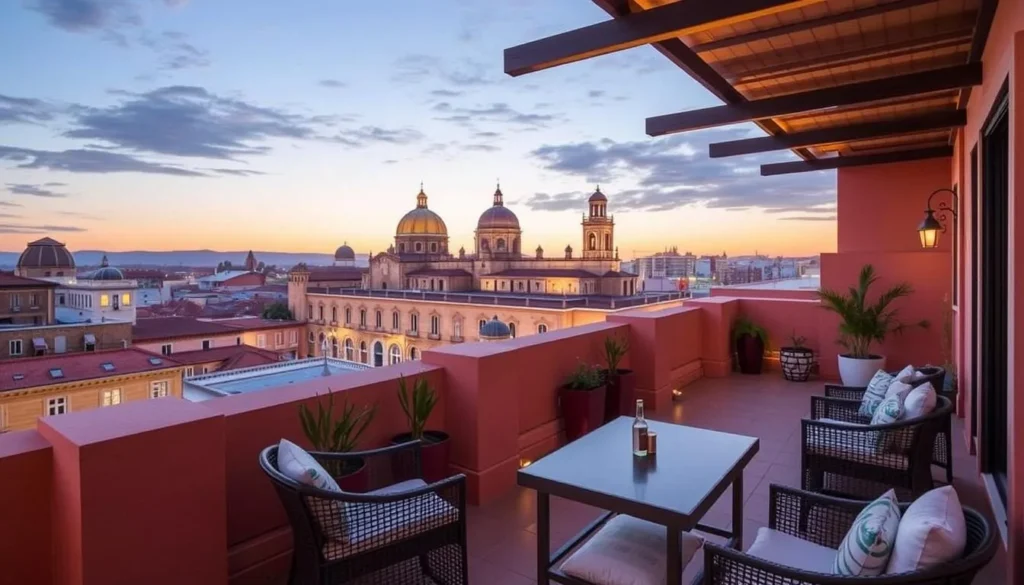
Luxury Accommodations
For a luxurious experience, consider staying at historic properties like Hospes Palacio de Bailío, which is housed in a 16th-century palace with Roman ruins beneath its glass floor. Another excellent option is Balcón de Córdoba, offering stunning rooftop views of the Mezquita-Cathedral. In winter, rooms at Balcón de Córdoba start at around $213.
Mid-Range Options
Mid-range travelers will find excellent value in boutique hotels like Hotel Viento10, with its 16th-century colonnaded patio, or NH Collection Amistad Córdoba, set in two renovated 18th-century mansions with traditional Andalusian courtyards. Hotel Viento10 offers modern rooms starting at €70, along with a spa and massages.
Budget-Friendly Stays
Budget-conscious visitors can opt for well-priced hostels and guesthouses in the city center, such as Hospedería Luis de Góngora or Hostal Maestre. These offer clean, comfortable rooms with local character at affordable prices. For a truly authentic experience, consider staying in a traditional house with a patio in the Jewish Quarter or the San Basilio neighborhood.
Staying in Córdoba’s historic center puts you within walking distance of major attractions, with the area around the Mezquita-Cathedral offering the most convenient location. Whether you’re looking for luxury, mid-range, or budget-friendly accommodations, Córdoba has something to suit every traveler’s needs.
Getting Around Córdoba
Córdoba is a city that invites exploration on foot, with its historic center being compact and pedestrian-friendly. You’ll find that many of its best-known monuments are practically next door to each other, making it easy to walk and discover the city’s hidden corners.
Walking Routes
The most scenic way to explore Córdoba is on foot, starting from the Roman Bridge, through the Jewish Quarter, to the Mezquita-Catedral, and then up to Plaza de las Tendillas. This route covers most major attractions and allows you to experience the city’s charm. As you stroll, you’ll have ample time to admire the architecture and soak in the local culture.
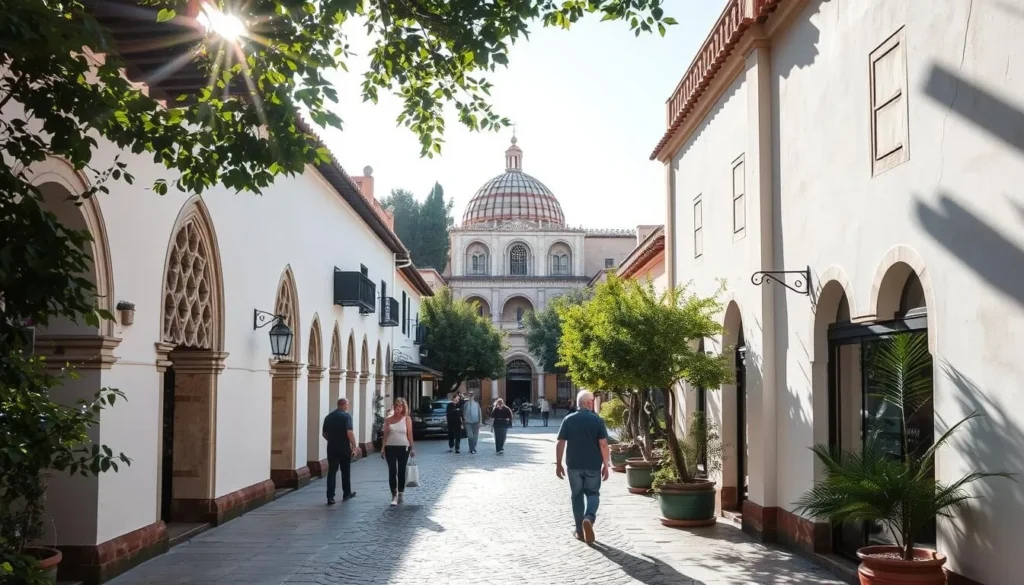
Public Transportation Options
For longer distances or when you need a break, Córdoba has an efficient bus network. Single tickets cost around €1.30, and the circular Line A is particularly useful as it connects the train station with the historic center. Taxis are also readily available and reasonably priced, with most rides within the city costing under €10. If you prefer a different way to get around, consider renting a bicycle to explore the city at your own pace, using the dedicated bike lanes.
Using these transportation options, you’ll find that getting around Córdoba is convenient, allowing you to make the most of your time in this beautiful city, with a local guide or on your own.
Conclusion: Making the Most of Your Visit to Córdoba
With its unique blend of cultures, Córdoba is a city that rewards travelers who take their time to explore its many attractions and experience the authentic spirit of this historic place.
To make the most of your visit, plan strategically by visiting major attractions like the Mezquita-Cathedral early in the morning or during lunchtime to avoid crowds. Save the charming patios and smaller museums for the busier midday hours. This way, you’ll be able to appreciate the city’s many things to see and do without the hassle.
Don’t miss the opportunity to experience Córdoba at different times of day. The monuments are beautifully lit at night, and the early morning offers a peaceful atmosphere before day-trippers arrive. Take a stroll along the Roman Bridge, visit the Alcázar de los Reyes Cristianos, and explore the narrow streets of the Jewish Quarter.
Each season offers its own charm: summer evenings are lively with outdoor dining and events, fall brings perfect weather and fewer tourists, and winter showcases holiday decorations and dramatically lower hotel rates. Allow yourself time to embrace the relaxed Andalusian pace of life—linger over a glass of Montilla-Moriles wine, take an afternoon siesta, and enjoy evening paseos with locals.
By following this guide, you’ll be able to experience the best of Córdoba and create unforgettable memories of your visit to this incredible city.
The above is subject to change.
Check back often to TRAVEL.COM for the latest travel tips and deals.


